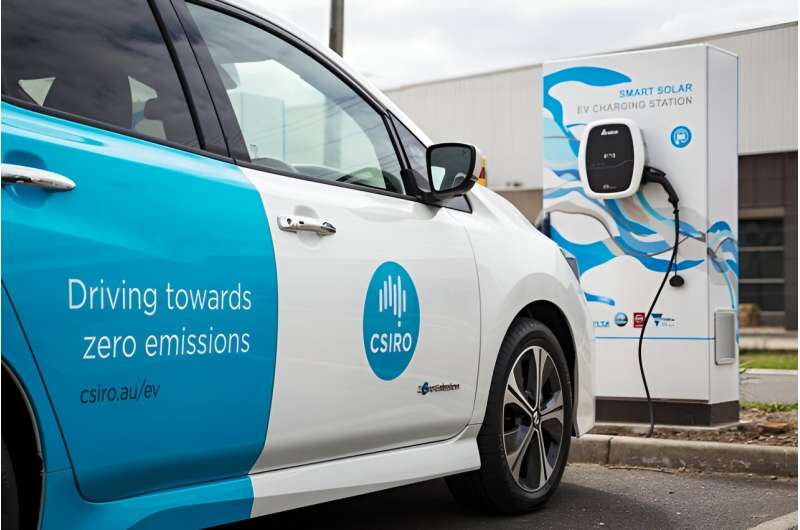This article has been reviewed according to Science X's editorial process and policies. Editors have highlighted the following attributes while ensuring the content's credibility:
fact-checked
trusted source
proofread
Changing gears: A guide to low emissions transport

Curious about decarbonizing your personal transport? Perhaps soaring fuel costs, new financial rebates and vehicle options has sparked your interest? Maybe it is your growing appetite for environmental action?
If so, you're not alone. The Electric Vehicle Council found more than 50% of Australians would consider an Electric Vehicle (EV) as their next car. In fact, sales have tripled in the last 12 months.
We're unpacking the latest low emissions transport options. We'll also touch on the challenges and critical research that is getting us on track for a cleaner transport future.
Taking charge of low emissions transport
Transport is Australia's third largest source of greenhouse gas emissions and increasing faster than any other sector. Cars account for roughly half of these emissions. Switching to an EV can have a huge impact on reducing your carbon footprint, even if charged from the grid (that mostly relies on fossil fuels for the time being).
Despite more EVs being introduced in Australia, supply constraints and high demand continues to limit model choice and availability.
Let's explore types of EVs and how they compare to standard Internal Combustion Engine (ICE) cars.
Hybrid
Powered by an internal combustion and electric motor. Regenerative braking and the ICE automatically recharge the battery.
- Pros: Thrifty on fuel, lower emissions, strong resale value, self-charging battery
- Cons: Higher purchase and maintenance costs, battery replacement is expensive, limited supply for some models
Plug-in hybrid electric vehicle (PHEV)
Offers the flexibility of using petrol or recharging the battery by plugging into the grid.
- Pros: Better fuel efficiency than a standard hybrid as it uses the electric motor more frequently, low emissions, opportunity to recharge with renewable energy
- Cons: Higher purchase cost, higher maintenance costs, limited model choice and availability
Battery electric vehicles (BEV)
Uses electrical energy stored in a rechargeable battery as its sole source of propulsion.
- Pros: Low running and maintenance costs, fast charging capability, silent, extra front boot space (where engine usually sits), zero emissions driving if charged with renewable energy
- Cons: Higher purchase cost, limited public charging infrastructure, reduced storage capacity in some models, it may require extra home charging investment, limited model choice and supply
There's more to the EV scene than just cars
Registrations of electric motorbikes, scooters and mopeds have taken off in recent years. They offer an affordable, low emissions transport alternative. With limited range and low top speed, scooters and mopeds are suited to inner city commutes. In some states they only require a C-class driver license.
The rise of micromobility
Micromobility is the use of small, mostly electric powered vehicles for short urban trips. They have rapidly surged in popularity since the first Australian public trials in 2018.
E-bikes, e-scooters, electric unicycles and e-skateboards offer affordable, fun and convenient mobility. They offer the potential to reduce traffic congestion, pollution, emissions and gaps in public transport.
But our relationship with this emerging transport mode has been strained. Widespread concerns for rider and pedestrian safety, infrastructure challenges and conflicting regulation between states and territories are some of the barriers.
Beyond electric: Powering ahead with clean hydrogen
No harmful emissions, greater range and fast refueling. It's easy to see why some consider clean hydrogen a fuel of the future.
Hydrogen-powered vehicles use an internal fuel cell. The driver refuels at a hydrogen bowser in around five minutes, like a petrol or diesel car. However, there is little hydrogen refueling infrastructure in Australia.
Currently there is a limited range of hydrogen-powered vehicles in Australia, which are not yet available for private purchase. The development and deployment of hydrogen is better suited to heavy transport vehicles such as trucks and buses. This energy is compatible with large loads, long journeys and a central base for refueling.
Navigating roadblocks
The predicted surge in EV ownership from the late 2020s will be driven by improved affordability, model availability and charging facilities. But our aging energy infrastructure (and phase-out of fossil fuel generation) will require more investment and distribution to cope with our complex energy habits.
We currently have just over 3,000 EV public charging stations in Australia. There have been calls for us to step on the pedal in order to reach the estimated 2.8 million required by 2030.
EV resource production and manufacturing also present challenges. Each vehicle requires around 200 kilograms of critical minerals, such as cobalt, nickel and lithium. That's six times more than a petrol car.
When EV batteries reach the end of their life, we need better strategies to recycle or repurpose them. While there are existing EV battery recycling programs in Australia, there's more work to be done in this area.
En route to a sustainable future
Our research is actively empowering Australia's transition to low emissions transport.
Our Revolutionary Energy Storage Systems Future Science Platform is developing radical new systems to meet future energy needs.
We are exploring solutions to improve grid reliability, capacity and sustainability, and we've introduced solar-powered EV charging stations. These stations will use smart technology to connect your solar, batteries and vehicle.
In 2021, we announced Australia's first clean hydrogen refueling station to enable real-world testing. We also launched the Hydrogen Knowledge Center as a resource to support the development of a clean and competitive hydrogen industry in Australia.
As Australia's largest minerals research and development organization, we are well placed to respond to critical mineral demand. This includes developing more sustainable mining methods and circular economy approach for rare earth metals.
We have prepared a number of reports on the potential for lithium battery recycling in Australia. Our research is also exploring the best ways to use these valuable metals and keep batteries from landfill.


















